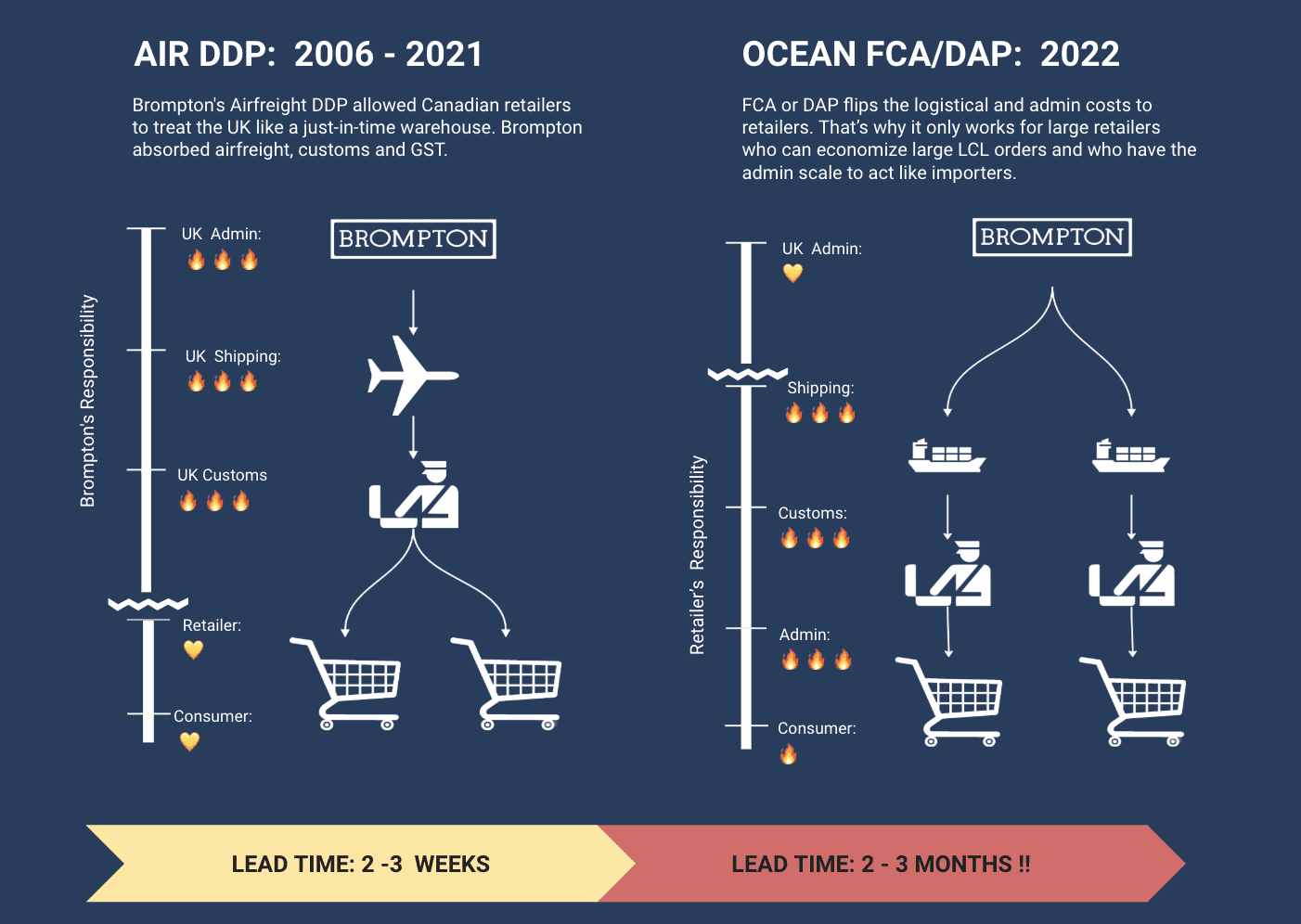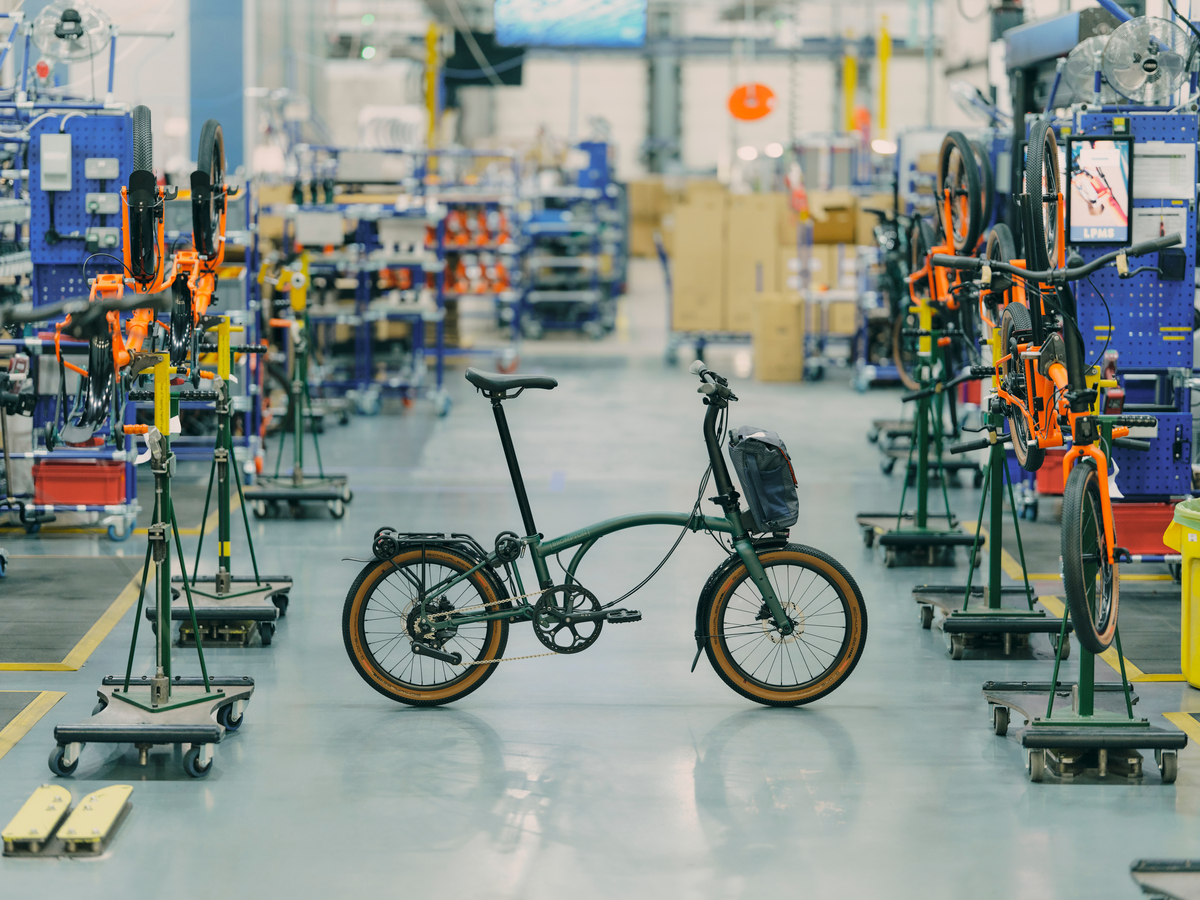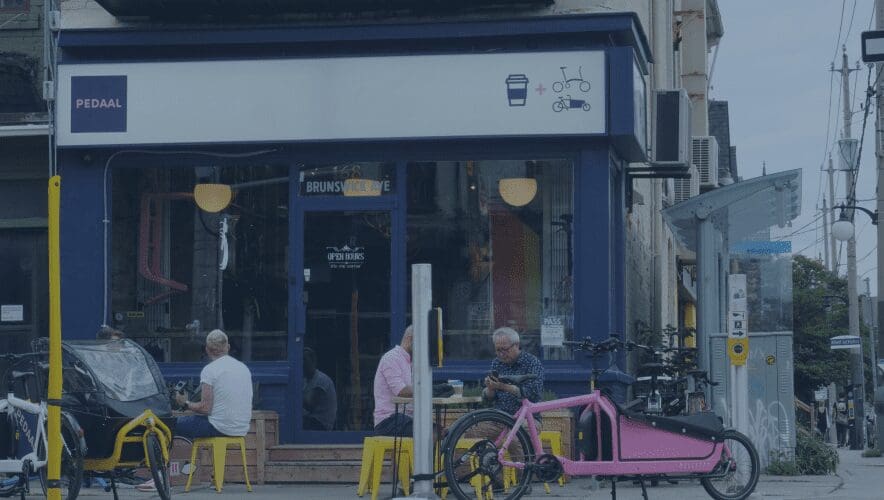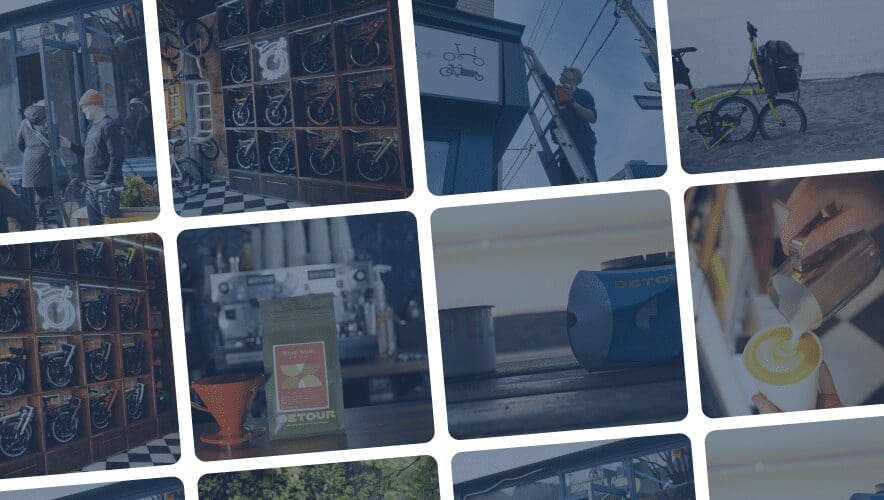If you’re shopping for a Brompton you may have noticed that Brompton pricing across Canada is… a little topsy turvy. This is strange, because Brompton publishes standardized pricing for their bikes and enforces what is called a MAP policy. This MAP pricing provides retailers a literal map for Brompton Bicycle pricing. Yet, some Canadian retailers – at least at the time of writing – are clearly operating off the map. They’re not charging too little, they are charging too much! Is there a good reason? To investigate, we might want to look at these MAP prices and ask what is going on.
Three Dimensional Pricing
At Pedaal we believe in the idea of a win-win-win concept. In a good Brompton transaction, the customer wins, the retailer wins, and Brompton wins. This three dimensionalism operates by the principle of fairness – which can in turn be reduced to numbers. The customer should get a good price, and both Brompton and the retailer a fair margin. This numbers game turns into a virtuous circle where Brompton can continue to innovate, the retailer can expand their reach, and the customer is always supported. Surplus value creates surplus value! (If you want to be an economist about it).

Three Dimensional Community
In the case of Brompton, this also builds a community. And, this community is special because it is also a movement. Brompton owners tend to be a bit religious about their bikes. Part of this is the way a Brompton unfolds their life. Part of it is a nod to the stubborn British company who got the concept folded up. They also tend to believe that a Brompton helps make ourselves healthier, our cities healthier, and our planet healthier. Brompton cares about this kind of stuff. So do we. It’s another win-win-win!
Bad Actors
Fair pricing is part and parcel of this movement. If retailers aren’t getting a good margin and customers aren’t getting a fair price, then these three dimensions of community buckle. And, quite often, some party is being exploited. Above all, these products exist for the sake of customers, so if the customer is being exploited that not cool.
Prices are off the Map
So, what is MAP pricing? MAP pricing means “minimum advertised pricing,” and, in the digital era it’s a way to ensure a retailer doesn’t discount prices in any sort of media, whether online or otherwise. MAP pricing is usually a defence against discounting and an appeal to integrity. The argument is that a brand like Brompton doesn’t need to be discounted because it adds a ton of value to your life. It saves you a mountain of money compared to other transportation options. It lasts a long time and costs very little in servicing. And, a Brompton is designed to do all of this for a very fair price. If you’re a retailer and know how to sell this, then there’s no need to discount. Note: if there are discounts on the Pedaal website they have been pre-approved by Brompton.
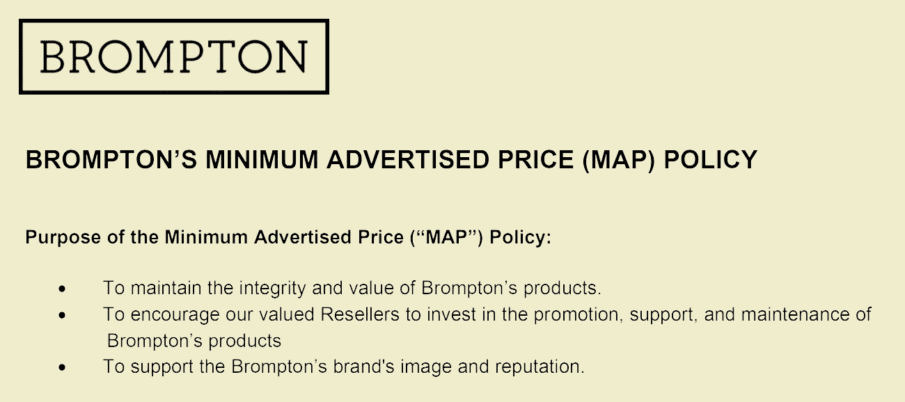
So, while MAP pricing protects a brands integrity from factory to retailer to customer, what it cannot do is protect the customer from getting gouged. It cannot, in other words, prevent a retailer from selling the bike for more than it should be.
Here’s the MAP
Since MAP pricing is meant to be published, we are going to assume Brompton won’t mind if we show you a screenshot of their price-list. What we will keep confidential is cost pricing, which we’ve redacted below. The question is: did you pay the MAP price for your Brompton? Or, did you pay more? Here are the official Brompton prices for Canada as of Friday, August 15th, 2025.
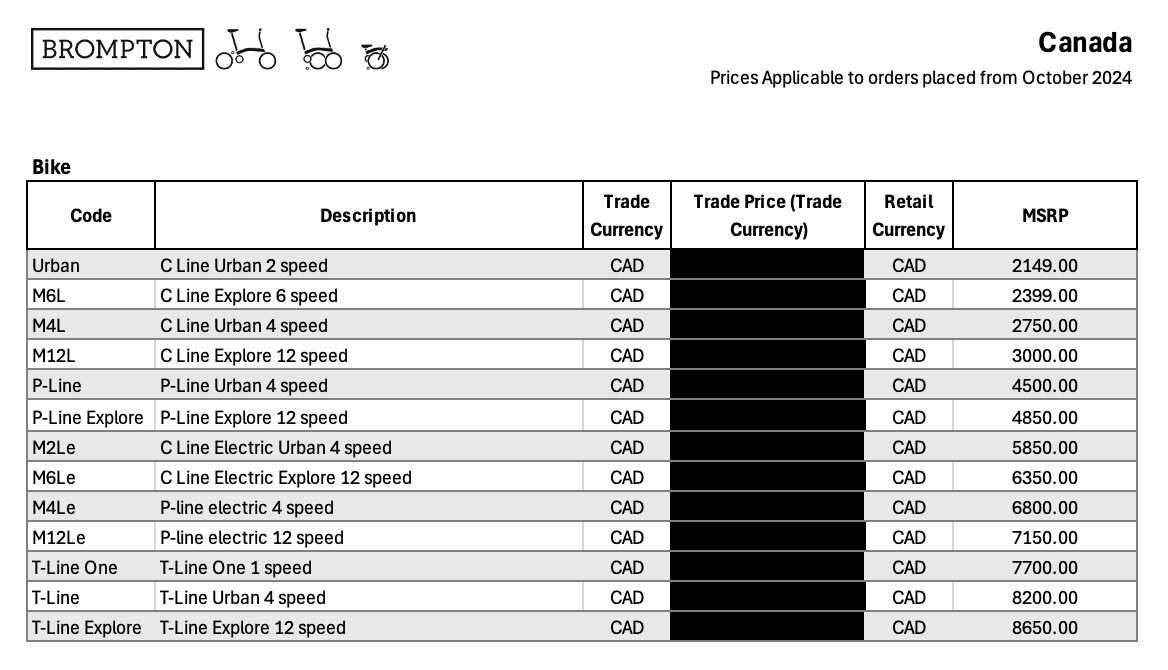
At Pedaal we follow the MAP price. At the time of writing there is are several retailers charging a 15% premium on top of Brompton MAP pricing. Bikes like the C-Line 6-speed, for instance, have had MAP pricing of $2400 since early 2021. Yet there are some retailers charging $2685, a $285 premium.
What’s the Background?
To be fair, one of the reasons that some Canadian retailers have gone rogue on Brompton’s MAP pricing is because they had no choice. This requires a short history. From 2006 to 2022, Brompton was an absolute win for the Canadian retailer and customer. In this period, Brompton airfreighted their bikes to the retailer and covered all shipping costs, duties, and customs charges. The UK warehouse was essentially a “just-in-time” warehouse for Canada. That kept the customer and retailers happy. And then, suddenly, Brompton stopped.
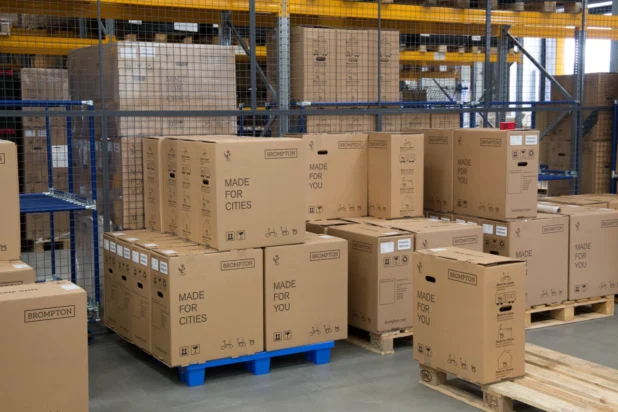
The reason is that it wasn’t a win-win-win. Brompton wasn’t making any money. And, it wasn’t just because airfreight prices were increasing, it was because they were also paying GST and duties on entry – and weren’t able to recover it. So, almost overnight in 2022 Brompton told Canadian retailers that they now had to order direct from the UK or from their newly established USA warehouse.
Misplaced Duties
There was a heavy dose of naiveté on Brompton’s part here. The USA office was designed to service both Canada and the USA, but unfortunately forgot that Canada is a sovereign country. While Canada has a free-trade agreement with the UK, bikes that are routed through the USA are charged duties on entry to Canada. Suddenly, buying from the USA meant that the retailer had to soak up 13% in duties. That’s fine for the occasional one-off, but as a business it’s not sustainable.
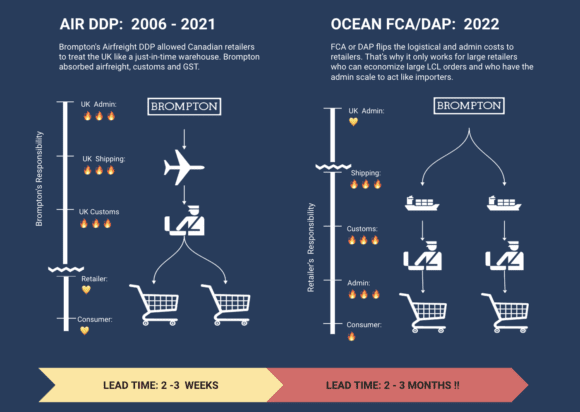
Upon realizing this, Brompton offered Canadian retailers to order direct from the UK. Twice shy and careful not to get a bloody nose, Brompton UK also declared that they would have nothing to do with the shipping. This created a lot of friction for the Canadian retailer. The retailer would now have to assume all of the risk and cost of importing. Lead-times went from one week to four months. Now add currency fluctuations and a expensive customs exam you can understand why Brompton has less than ten Canadian retailers.
Interim Remapping
But, the real problem was Brompton’s Canadian MAP pricing. It wasn’t calculated on real factors. On one hand it hadn’t included duties from the US to Canada, and on the other hand, the cost of ocean shipping from the UK. Thus, if a retailer was to follow Brompton’s MAP pricing in 2022, they would have assumed below-industry margins and a dangerous amount of risk. That’s why in 2022 many retailers raised prices. They needed to ensure they could maintain industry-standard margin. And, they made their complaint known to Brompton.
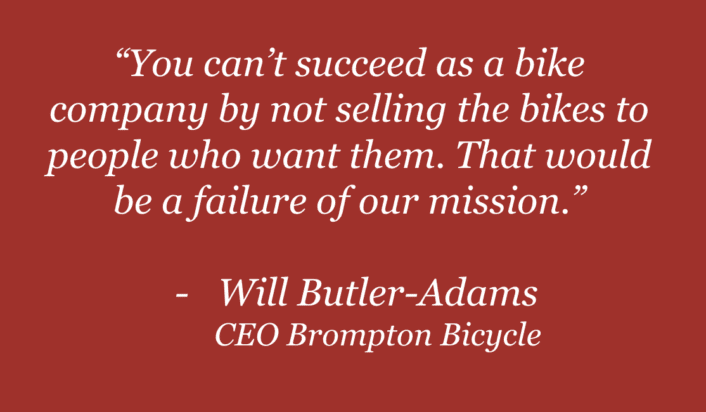
Remedial Solutions
In 2024, Brompton listened. First, they switched retailers payment currency to Canadian Dollars. That meant that Brompton was absorbing the currency risk, which is the normal responsibility of an importer. Second, they increased retailer margins to in order to help absorb the shipping costs. This didn’t solve the headache of long lead times, but it offered a remedial solution. All of this meant that a retailer could finally sell a Brompton for MAP price and make a fair margin. But, it also meant retailers had to absorb the time and cost of importing, and, there was no way they could possibly represent the full range of product.
So, why are some retailers selling this bike for a premium? In the case of smaller retailers, it’s quite possible they haven’t updated their prices since Brompton is the least of their priorities. But, in the case of larger retailers, there really isn’t any explanation. They are clearly gouging customers.
In Conclusion
We began by saying that fairness is three dimensional and involves the customer, the retailer and the supplier. And, we noted that in the case of Brompton, this creates something extra, a community. While the Brompton community is strong, the balance between supplier, retailer and customer is a constant juggling act. Brompton is all too aware that the supply-side in Canada needs a more permanent solution.

Yes, it is not easy to be a Brompton retailer in Canada right now. You need a really good bookkeeper, a tolerance for risk, and a willingness to accept modest bike-industry margins without any bonus for the extra hassle. At Pedaal, that’s the map we accept and follow. And, we keep pushing for change. That’s how a community is grown. And, especially in these strange times, that’s how an ever-widening cycling culture is grown.
Stay in the Know. Join our Newsletter!

